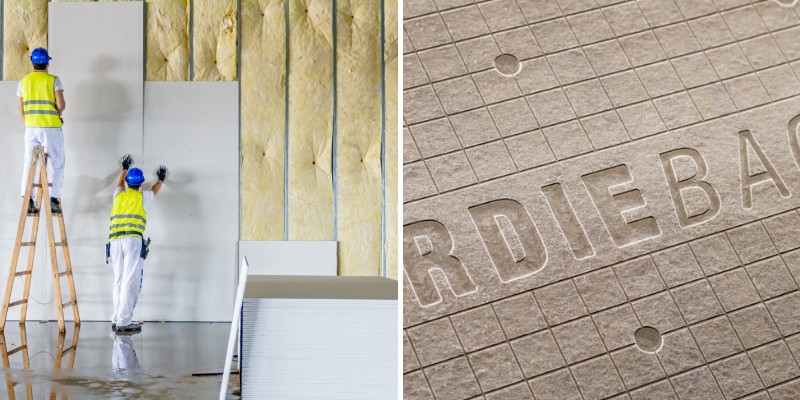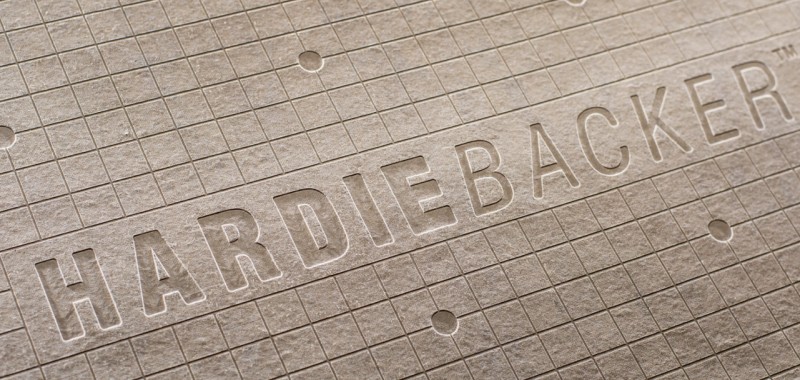The number of choices today’s contractors and homeowners face when choosing materials necessary to finish interior walls has grown exponentially over time.

While the mainstay remains standard drywall, other materials are being identified as being more appropriate for certain areas of the home.
Cement backer board, once relegated to outdoor projects, is fast becoming a popular option, but before you say yes to using either, consider the various pros and cons of Drywall Vs Cement Backer Board before making a buying decision.
What is Greenboard Drywall?
This moisture-resistant drywall type is often the first choice of contractors and DIY homeowners when they remodel spaces that are likely to be exposed to humidity because greenboard stands up to water exposure better than standard drywall.
This water-resistant gypsum panel debuted in the 1960s to enthusiastic remodelers and it’s easy to recognize due to the green tint added to the paper that is treated to a wax sealant before it’s sold.
Thicker than standard drywall, greenboard is sold in panels that are either ½-inch or 5/8ths-inch thick.
Pros of Greenboard
- -It’s designed to be installed in areas like bathrooms, laundry rooms and areas subject to outdoor intrusions.
- -Greenboard does a great job of rebuffing organic growths like mold or mildew.
- -It’s available at a variety of retail stores and at varying prices, from hardware to big box stores.
- -It’s a breeze to cut using nothing more than a sharp utility knife and metal straightedge.
- -It’s installed just like drywall, but greenboard comes with more attachment options that run the gamut from screws to grout and other adhesives.
Cons of Greenboard
- -It’s more difficult to cover up seams when taping and mudding sections that have been installed.
- -Greenboard is not waterproof; it just resists moisture better than standard drywall.
- -Greenboard is not fire resistant, so it shouldn’t be used at high-risk locations.
- -Since it’s heavier than regular drywall, ceiling installation calls for special methods or sagging could result.
- -If it becomes completely saturated, greenboard can weaken faster than traditional drywall.
What is Cement Backer Board?
Are you so new to the world of interior wall construction that you’ve not yet run into the term “cement backer board”?
We’ve got you covered with a short introduction to this modern material that not only substitutes for drywall but because it’s made without organic materials, panels won’t shrink, rot, attract mold or decompose over time.
There’s more. Cement backer board is versatile. The mineral-based pre-fabricated sheets are made of cement, silica, limestone flour and water and infused with Kevlar or fiberglass.
Further, these sections can be installed using grout, mortar or thin set – or you can use nails and screws to secure sections to framing.

Find cement backer board at home supply and hardware stores under brand names that include WonderBoard, Durock, PermaBase and HardieBacker, but “they are all basically equivalent” say experts.
Pros of Cement Backer Board
- -It’s available in both ¼-inch and ½-inch thicknesses.
- -Backer board won’t mildew or break down if exposed to moisture/leaks.
- -HardieBoard, a popular type, is lighter, easier to install and it cuts uniformly.
- -Makes a great substitute for greenboard in area prone to moisture.
- -Not as susceptible to water damage as drywall.
- -Cement backer board bonds with tiles better than gypsum board.
Cons of Cement Backer Board
- -Per square foot weight makes it difficult to lift, carry and install.
- -4- x 8-foot sheets of cement backer board aren’t sold; you’ll need more sheets to finish your project.
- -It’s not completely waterproof; you’ll still need to install a moisture barrier.
- -Cutting requires carbide-tipped tools and saw blades to get precise sections.
- -Cement backer board tends to be more expensive than products like greenboard.
Drywall Advantages over Cement Backer Board
- -It’s easier to find and comes in more thicknesses and patterns.
- -Drywall is cheaper to buy and easier to install.
- -Panels are lightweight so workers are less likely to be injured.
- -It is ideal for emergency repairs because it is so versatile.
- -You can transport more boards at a given time.
- -It is relatively easy to score and cut compared to cement board.
- -Drywall is easier to position, seam and refinish.
Cement Board Advantages over Drywall
- -Cement board won’t break down like drywall over time.
- -It’s an ideal solution for interior walls where moisture and water are likely.
- -Offers an extremely strong base for tile installation.
- -Won’t warp or rot like standard drywall products.
- -Chances of mold and mildew growth are slim to none.
- -Also works as underlayment for floor installs
- -Some cement backer boards tolerate high heat.
- -This material provides an extra hour of fire protection.
Cost of Drywall
Given the growing number of drywall products on today’s market, it can be hard to determine a budget. But the Home Advisor website is in the business of calculating averages based on extensive research, so for 2021, you can use these numbers when figuring out how much you are likely to spend on your unique job.
-On average, drywall costs $15 per 4- x 8-foot panel. This is based on pricing from varying geographic areas that sell these sheets for between $12 and $20 each.
-If your goal is to apply drywall to the walls and ceiling of a 200-square-foot room based on these prices, expect to allocate between $300 and $500 for this part of your rehab project at between $0.40 to $0.65 per square foot.
-Thicker forms of drywall designed to add soundproofing and fire-retardant properties to the sheets are heavier and could cost you as much as $60 per panel, depending upon the benefits accorded to that type of drywall.
Cost of Cement Backer Board
Because cement backer board was originally made to be used on home exteriors (like siding), your search for pricing could be confusing, but if you prefer it over drywall, heating and cooling bill reductions could even out the cost so it’s worth investing in it if you have the choice.
According to Homewyse, you can anticipate spending the following if you purchase cement backer board:
-The cost of non-discounted, 7/16th-inch backer board runs between $115 and $172 to purchase enough material to finish a 120-square-foot room
-Basic labor costs for a 6.8-hour job is estimated at between $457 and $742 for that 120-square foot room.
-The total bill associated with this 120-foot job is most likely to run between $595 and $941.
-Taken down to its lowest denominator, expect to spend between $4.96 and $7.84 per square foot.
4 reasons you should purchase either type in bulk
It goes without saying that every time you shop for merchandise, you’ll pay retail pricing, so one of the best ways to finish home projects that entail buying a large number of panels is to buy in bulk.
According to construction experts, there’s no reason why consumers can’t follow in the footsteps of contractors by speaking up and asking for bulk pricing at the point of sale. Do this and you gain these advantages:
- You save money that can be applied to other projects costs associated with the job.
- By acquiring all raw materials up front, you save time.
- Choosing panels from the same lot means you get uniformity and consistency.
- You could even finish your job ahead of schedule!
Resources
https://www.thespruce.com/cement-backer-board-1821658
https://modernize.com/homeowner-resources/other/what-you-should-know-about-water-resistant-greenboard-drywall
https://www.hunker.com/13723028/cement-backerboard-what-you-need-to-know
https://en.wikipedia.org/wiki/Cement_board
https://www.sunrisespecialty.com/bathroom-drywall
https://diy.stackexchange.com/questions/85919/cement-board-vs-dry-wall
https://findanyanswer.com/is-concrete-board-heat-resistant
https://www.homeadvisor.com/cost/walls-and-ceilings/sheetrock-drywall-prices/
https://www.builddirect.com/blog/how-to-use-fiber-cement-board-as-an-interior-surface/
https://www.homedepot.com/b/Building-Materials-Drywall-Cement-Boards/N-5yc1vZcb0f
https://www.homewyse.com/services/cost_to_install_backer_board.html
https://remodelersadvantage.com/4-benefits-buying-construction-materials-bulk/
Related Posts
- Comparison of Shiplap vs “Tongue and Groove” vs Beadboard Wall Paneling
- Comparison of Manufactured vs Modular Homes with Pros/Cons
- 10 Different Types of Glass for Home Windows (With Pros and Cons)
- Here Are The Main Pros and Cons of a Barndominium House
- Main Advantages and Disadvantages of Vaulted Ceilings for Homes
- Top 9 Drywall Alternatives for Your Home Ceiling (With Photos)
Leave a Reply